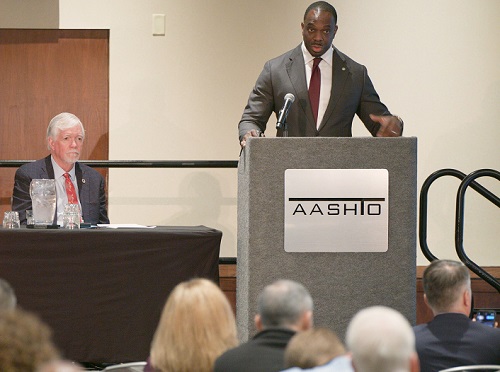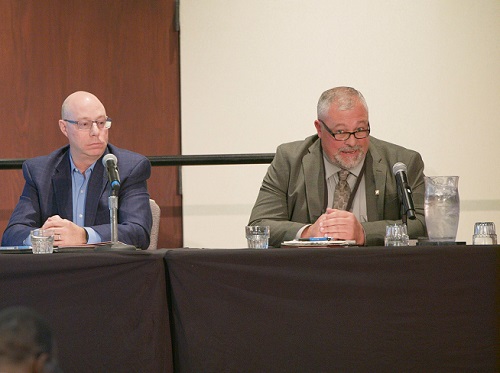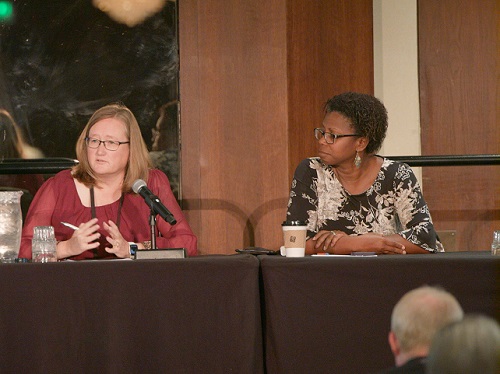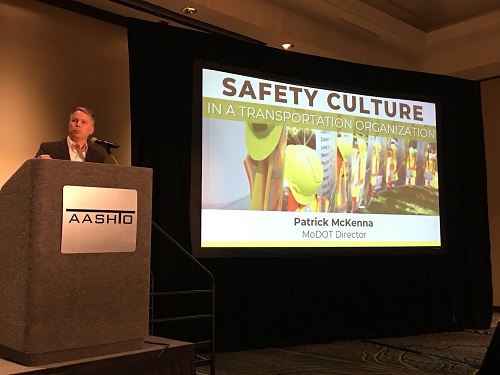At the 2023 AASHTO Safety Summit, state department of transportation leaders discussed how to integrate safety more deeply throughout their organizations as well as throughout the lifecycle of the infrastructure projects they oversee.
[Above photo of Patrick McKenna by AASHTO]
This panel discussion during the summit – hosted by the American Association of State Highway and Transportation Officials in mid-October in Kansas City, MO – featured state DOT leaders from across the country and touched on everything from planning and design protocol to performance measurement metrics.
Patrick McKenna – director of the Missouri Department of Transportation, chair of the AASHTO Committee on Safety, and a former AASHTO president – explained that his agency relies on its “Safety Assessment for Every Roadway” or “SAFER” tool to help it improve safety at the front end of the transportation project lifecycle.
“This tool is a list of questions we go through at the design phase and during the heavy maintenance for our roadways,” he explained. “Crucial to this process is the issue of public engagement – and we don’t use public engagement to advance safety solutions enough. We need to incorporate the public early and often in the project planning stage; that helps us find common ground between economic interests of the community and the safety improvements we’re trying to make.”

Toks Omishakin – secretary of the California State Transportation Agency and previously director of the California Department of Transportation – said a notable “shift” is occurring in the infrastructure project space where safety is concerned.
“Now we are taking more of a ‘people focus’ with the ‘core four’ project priorities established for California: Safety, equity, climate action, and economic prosperity,” he said. “But we can’t do this in a vacuum; we have to partner with community leaders and academia, all different sectors to accomplish this.”
Omishakin also quoted President John F. Kennedy in relation to this issue. “Kennedy said, ‘The time to repair the roof is when the sun is shining.’ The sun is shining on us right now; this is the time to get this done. The funding is there, the collaboration is there. We can absolutely do this now,” he said.
Sondra Rosenberg, assistant director of planning for the Nevada Department of Transportation, noted that performance metrics play a large role in the safety aspect of project planning as well.

“We know safety needs to be on the forefront of planning – but integrating safety as a priority is not just for the planning side but for funding and other [project] disciplines as well,” she explained. “There is a lot of overlap between planning and funding and safety. So as we look at where safety needs to be in the future of project lifecycles, we need to see how we can use metrics to get there.”
Shanté Hastings, deputy secretary of Delaware Department of Transportation, pointed out during the session that all transportation agencies need to understand that project design processes affect outcomes – and that doing the same things will not change outcomes.
“Context is critical; rural versus urban road needs, for example,” she said. “And balancing the needs of all the different transportation modes – cars, transit vehicles, pedestrians, and bicycles – is a challenge. We also need to look at creating more flexibility in the design process in order to better address specific community context.”

Neil Boudreau, assistant administrator for traffic and safety at the Massachusetts Department of Transportation, pointed out that as state DOTs become “strong advocates for change and fight for change,” they must also address the funding issues that might develop from those issues.
“We can’t hide behind cost – we must take the extra step and acknowledge that, to make a road safer, it may cost a little more,” he said. “Sometimes we get too fixated on the mobility improvements; it requires changing perspective to deliver a higher level of safety.”
However, Shawn Smith – senior project manager at the Maine Department of Transportation – reminded the session’s attendees that enhancing safety throughout the project lifecycle intrinsically includes improving safety for the workers building and maintaining that infrastructure.
“It is a dangerous thing to build and maintain roads – and when incidents happen they take a toll on everyone,” he said. “It is stress of being in precarious work position: and a confined position as well. This creates a level of mental anguish in the highway work zone and we must take a holistic approach to address this.”

Smith said there are many resources in the “toolbox for construction site management” but often resources are lacking for buttressing the mental health of the workers themselves. “The mental health perspective is something we also need to work upon – how do we develop our plans that include that focus and all the stakeholders involved in a project,” he noted.
Becky Allmeroth, chief safety and operations officer for the Missouri DOT, noted that technology will play a huge role in this area; helping gather critical data to identify where employees are at highest risk in the infrastructure construction and maintenance process.
“There is an unhealthy level of turnover in highway maintenance – we are losing half of our workers before they make it to their second or third year,” she explained. “Take our snowplow operators – they have a very stressful job. So we’re looking at system automation so all they need to do is focus on driving, not the plow’s position and salt spreader activity.”
Lisa Wilson, deputy director of engineering and operations at Utah Department of Transportation, echoed Allmeroth’s point, noting that technology can indeed save lives but that such investments to improve safety need to start early.
“As we move into a world where the focus is on people and improving quality of life for our stakeholders, technology will be crucial,” she stressed. “Because more data helps us generate better solutions.”
 Top Stories
Top Stories
Modal Administrators Speak at AASHTO Annual Meeting
December 5, 2025 Top Stories
Top Stories

